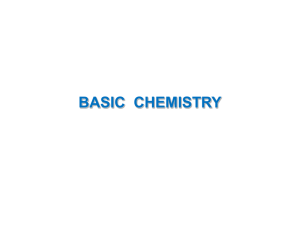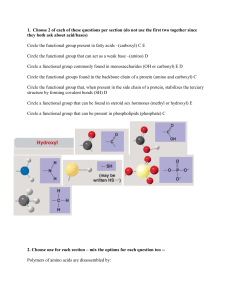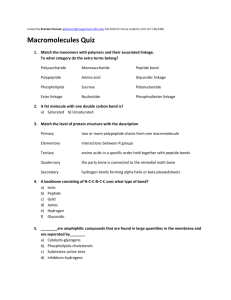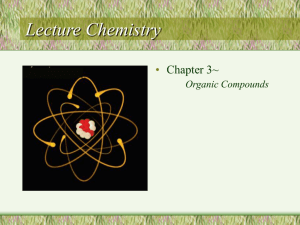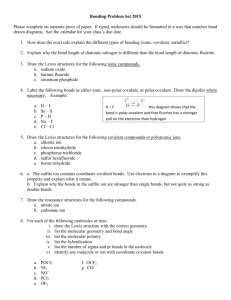Chp 2 Chemical Elements and Compounds Matter Element
advertisement
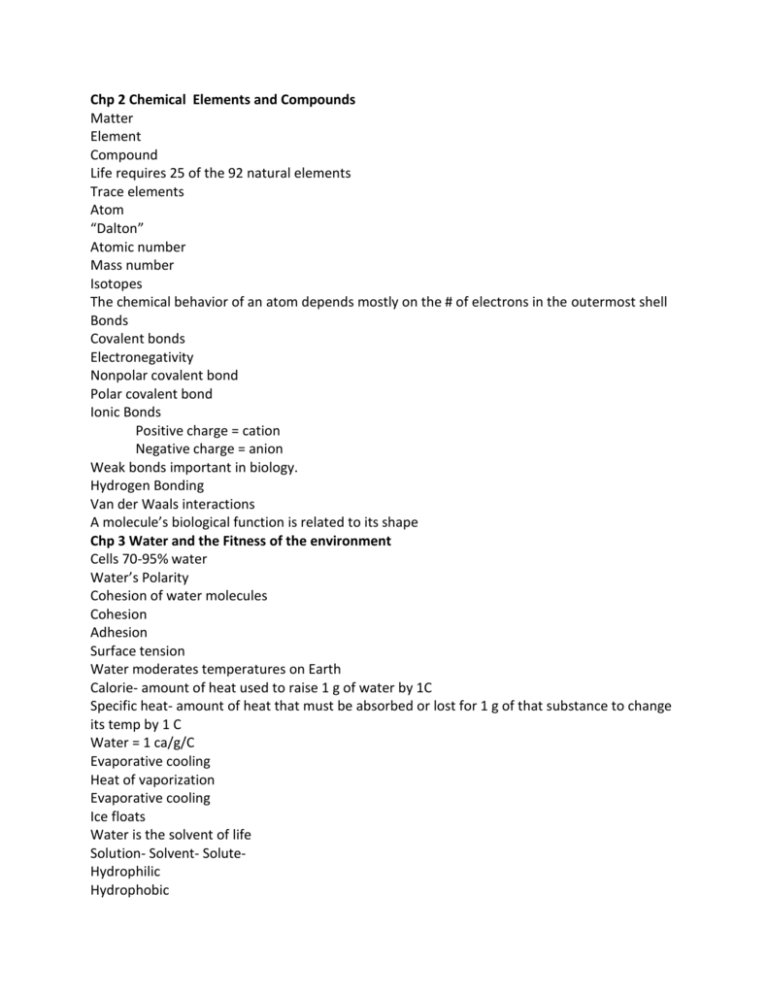
Chp 2 Chemical Elements and Compounds Matter Element Compound Life requires 25 of the 92 natural elements Trace elements Atom “Dalton” Atomic number Mass number Isotopes The chemical behavior of an atom depends mostly on the # of electrons in the outermost shell Bonds Covalent bonds Electronegativity Nonpolar covalent bond Polar covalent bond Ionic Bonds Positive charge = cation Negative charge = anion Weak bonds important in biology. Hydrogen Bonding Van der Waals interactions A molecule’s biological function is related to its shape Chp 3 Water and the Fitness of the environment Cells 70-95% water Water’s Polarity Cohesion of water molecules Cohesion Adhesion Surface tension Water moderates temperatures on Earth Calorie- amount of heat used to raise 1 g of water by 1C Specific heat- amount of heat that must be absorbed or lost for 1 g of that substance to change its temp by 1 C Water = 1 ca/g/C Evaporative cooling Heat of vaporization Evaporative cooling Ice floats Water is the solvent of life Solution- Solvent- SoluteHydrophilic Hydrophobic H2O + H2O -> H3O+ (Hydronium ion) and OH- (Hydroxide ion) H2O <-> H+ and OHAcid-Adds H+ to solution Base- Soaks up H+ or adds OHpH Scale Buffers Buffers accept hydrogen ions when excessive and donating hydrogen ions when depleted. (usually acid-base pairs) Carbonic acid (H2CO3) Chp 4. Carbon and the molecular diversity of life The importance of carbon Stanley Miller The chemical characteristics of carbon are a result of its configuration of electrons Carbon has little tendency to gain or lose electrons and form ionic bonds Usually forms covalent bonds by sharing its four electrons Tetravalence- an intersection point from which a molecule can branch off into four directions Carbon skeletons: vary in length, double bonds, branching, rings Isomer Structural isomers Geometric isomers Enantiomers Functional Groups Hydroxyl Group: Alcohols –OH Carbonyl Group: C=O Aldehyde Ketone Carboxyl Group: -COOH Amino Group: -NH2 Sulfhydryl Group : -SH Phosphate Group Chp 5 The Structure and Function of Marcomolecules Polymer Monomers Condensation reaction Hydrolysis Carbohydrates Monosaccharides Aldose Ketose Disaccharide glycosidic linkage (a covalent bond formed from dehydration reaction) Polysaccharide Provide energy storage or used for structural purposes Starch Glycogen Cellulose Starch- alpha linkage, helical shape Cellulose- beta linkage, straight shape Chitin- Similar to cellulose except has a nitrogen containing appendage to the glucose. Lipids Fats Fat: fatty acids attached to glycerol 3 fatty acids join to one glycerol triacylglycerol (or triglyceride) Saturated fat vs unsaturated fat Animal fat- usually saturated- solid at room temperature Plant and fish fat- usually unsaturated- liquid at room temperature 1 gram of fat stores 2x energy as starch Phospholipids Micelle Phospholipid bilayer Steroid Cholesterol Proteins 20 different amino acids peptide linkage Function as support, storage, transport, signaling, defense, movement, and catalysts EnzymesAmino Acid Structure Amino, carboxyl and R groups Amino acid linkage Peptide bond- covalent bond catalyzed by a dehydration reaction Amino end: N-terminus Carboxyl end: C-terminus Four Levels of Protein Organization Primary- Sequence of amino acids Secondary- coils or folds Result from hydrogen bonding on the backbone of the chain (not the R groups) Alpha helixBeta pleated sheet Tertiary Structure Hydrophobic interaction- van der Waals interactions Disulfide bridgesTwo sulfhyryl groups (-SH) form covalent bond Quaternary Structure DenaturationChaperonins- (chaperone proteins) Nucleic Acids Purines and Pyrmidines Deoxyribose Ribose Phosphodiester linkagesJames Watson and Francis Crick 1953 Nucleotides 5-C sugar, phosphate and nitrogenous base Evolutionary relationships

